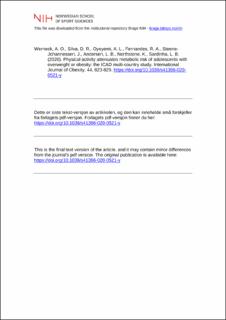| dc.contributor.author | Werneck, André O. | |
| dc.contributor.author | Silva, Danilo R. | |
| dc.contributor.author | Oyeyemi, Adewale L. | |
| dc.contributor.author | Fernandes, Rômulo A. | |
| dc.contributor.author | Steene-Johannessen, Jostein | |
| dc.contributor.author | Andersen, Lars Bo | |
| dc.contributor.author | Northstone, Kate | |
| dc.contributor.author | Sardinha, Luís B. | |
| dc.date.accessioned | 2021-02-10T10:12:34Z | |
| dc.date.available | 2021-02-10T10:12:34Z | |
| dc.date.created | 2020-07-29T13:46:33Z | |
| dc.date.issued | 2020 | |
| dc.identifier.citation | International Journal of Obesity. 2020, 44, 823-829. | en_US |
| dc.identifier.issn | 0307-0565 | |
| dc.identifier.uri | https://hdl.handle.net/11250/2727129 | |
| dc.description | I Brage finner du siste tekst-versjon av artikkelen, og den kan inneholde ubetydelige forskjeller fra forlagets pdf-versjon. Forlagets pdf-versjon finner du på nature.com / In Brage you'll find the final text version of the article, and it may contain insignificant differences from the journal's pdf version. The definitive version is available at nature.com | en_US |
| dc.description.abstract | Background: Although the benefits of physical activity (PA) at an early age are well established, there is no robust evidence of the role of PA as well as its intensities in attenuating the association between weight status and metabolic risk among adolescents. In this investigation, we analyzed the association between weight status, intensities of PA, and metabolic risk among adolescents. Methods: Data from six cross-sectional studies in the International Children’s Accelerometry Database were used (N = 5216 adolescents; boys 14.6 ± 2.1 years and girls 14.7 ± 2.0 years). Weight status was assessed and classified according to body mass index. Fasting glucose, triglycerides, inverse high-density lipoprotein cholesterol, and blood pressure composed the metabolic risk indicator (z-score). PA was measured by accelerometers. The estimated age of peak height velocity was used as a covariate for somatic maturation. Results: We observed that increase in weight status showed a strong positive relationship with metabolic risk. However, adolescents with overweight or obesity in the highest tertile of PA (moderate-to-vigorous and vigorous intensity) showed a similar metabolic risk score as the normal weight groups. Moderate intensity PA seemed related to metabolic risk even within some categories of vigorous PA. Conclusions: We conclude that PA attenuates the metabolic risk of adolescents with overweight or obesity. Although this attenuation is largely explained by vigorous PA, moderate intensity seems also important for better metabolic profile. | en_US |
| dc.language.iso | eng | en_US |
| dc.subject | ICAD | en_US |
| dc.subject | physical activity | en_US |
| dc.subject | overweight | en_US |
| dc.subject | obesity | en_US |
| dc.subject | adolescent | en_US |
| dc.title | Physical activity attenuates metabolic risk of adolescents with overweight or obesity: The ICAD multi-country study | en_US |
| dc.type | Peer reviewed | en_US |
| dc.type | Journal article | en_US |
| dc.description.version | acceptedVersion | en_US |
| dc.source.pagenumber | 823-829 | en_US |
| dc.source.volume | 44 | en_US |
| dc.source.journal | International Journal of Obesity | en_US |
| dc.identifier.doi | 10.1038/s41366-020-0521-y | |
| dc.identifier.cristin | 1820916 | |
| dc.description.localcode | Institutt for idrettsmedisinske fag / Department of Sports Medicine | en_US |
| cristin.ispublished | true | |
| cristin.fulltext | postprint | |
| cristin.qualitycode | 2 | |
